Spain Housing Market Price Crash Has A Long Way Further To Drop
Housing-Market / Spain Mar 04, 2013 - 01:12 PM GMTBy: Raul_I_Meijer
 Ilargi: I received another entry from Dave Fairtex, who delves into Spanish houding data this time around. We had a nice discussion about it, since I question some of the assumptions on which he bases his interpretation of the data. In particular, I think Dave assumes 2 things:
Ilargi: I received another entry from Dave Fairtex, who delves into Spanish houding data this time around. We had a nice discussion about it, since I question some of the assumptions on which he bases his interpretation of the data. In particular, I think Dave assumes 2 things:
1) That, during the - ongoing - bust, Spanish home prices will fall to the level they were at when the boom began (a drop of 55%), and then stop falling right there.
2) That there is a bottom underneath prices, determined by their "utility value", i.e. people will always need to live somewhere.
As for 1), it immediately makes me think of a series of 3 graphs we use in Nicole's presentations, and which those of you who have acquired our DVD set "A World of Change" will readily recognize:
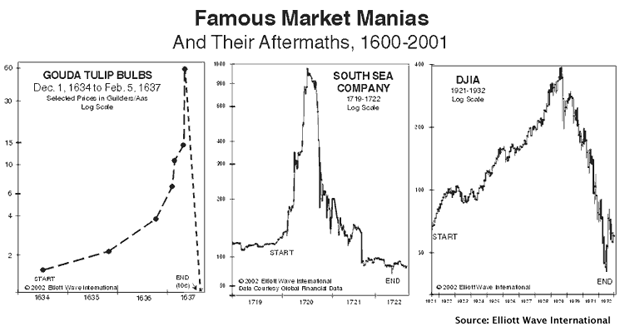
What you see is that in these 3 crises, the end point is (way) below the starting point, due to what can be called the "undershoot". In each case, it makes prices fall by well over 90% of its peak level. Now, Dave says he thinks homes are not tulips,
and so 2) the utility value of a house will make sure prices won't fall below the point their boom started. Not only do I find this too arbitrary an assumption (though, granted, in Dave's view he derives it from his data), there are a few other things that I feel may well influence this. That is, Spain built a huge amount of homes (more than Germany, France and Britain combined for 10 years), of which many are of too poor a quality to last for more than 20 years.
Moreover, something is true in Spain as it is all over the west: compared with 50 or 100 years ago, we occupy far more square meters per capita. That means there's a potential elasticity in that if prices remain too high, people will - forcibly - move (back) in together with family. Because we can. Demand is not what we want, but what we can afford. Seeing that youth unemployment in Spain presently stands at some 60%, you really need to wonder who's going to buy any homes there at all in the near future, and hence what bottom is supposed to apply to this housing market. It's tempting to think things must normalize at some point, but Spain has a crisis that extends far beyond housing.
I think we too easily overlook the potential for self-reinforcing, positive feedback across an economy. If Spain were to recognize the full 55% price drop, that would be the end of a large part of its banking system. And that in turn, for instance, would drive prices further down.
If the government in Madrid were more pro-active in restructuring the debts its banks hold, we would at least have a more accurate picture, but Spain does as the rest of Europe does: hide the debt behind more debt. The $25 billion loss announced by government-owned Bankia this week is a sign of what's going on behind the curtain, but no more than that.
Here's Dave and his data:
Dave Fairtex:
It is relatively well known that Spain has issues with their banking system, and that there was a property bubble and it popped several years ago. Various estimates have been floated as to how much it will cost to resolve the problem. But determining cost is not the only interesting question.
We want to be able to answer four questions:
• How much will it cost to resolve the problem?
• How long will it take to "return to normal"?
• How will we know when "normal" has been reached?
• What effects might this process have on spanish society?
The Bubble
It has been said that during a bubble pop, pricing always returns to its place of origin. This makes sense, as the prices one pays for something, once bubble psychology is removed from the equation, is tied to the actual utility received from having the item. That level is most likely the point at which prices diverged from the norm.
So, the first step in determining the cost involves identifying the point of origin of the bubble. Viewing a Spanish property price chart, one might argue that Spain's bubble started in approximately 2002. The start date is a relatively arbitrary designation - I picked a date when the trend of property price increases started to become particularly steep.
[Instead of using nominal prices for homes, I considered using real prices - i.e. prices deflated by the CPI. Then I concluded that the inflation that occurred on the way up would most likely be balanced by deflation on the way down. I am not sure this is true, but its one of the assumptions I made.]
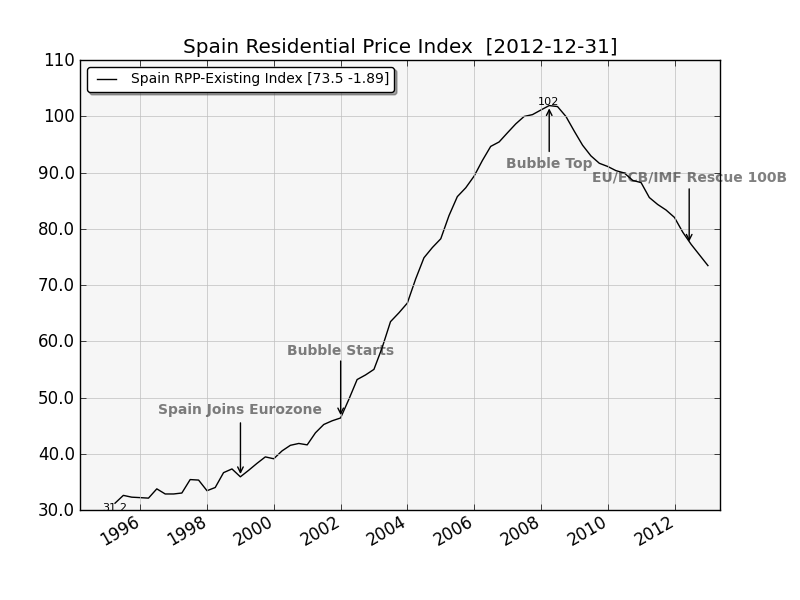
So where are we now? Doing some quick math on this index provided by the Spanish Ministerio de la Vivienda it appears that home prices are down 27% from peak. However, anecdotal evidence from 2012 suggests property prices are closer to 35-40% below peak, and recoveries from foreclosure sales by a Spanish bank in 2012 show a 53% recovery rate - a 47% drop.
So let's say the preceding chart is not telling us the truth or if we're kind, we can say it lags substantially behind realtime. Likely instead of 73, it should probably be reading around 60. Operating under the assumption that prices will eventually return to around 45, that says prices are going to be off around 55% from peak when all is said and done. From a property pricing standpoint, we have another 33% left to go (60 to 45 = 33% drop from here). Perhaps the real price correction will end somewhere in mid 2014.
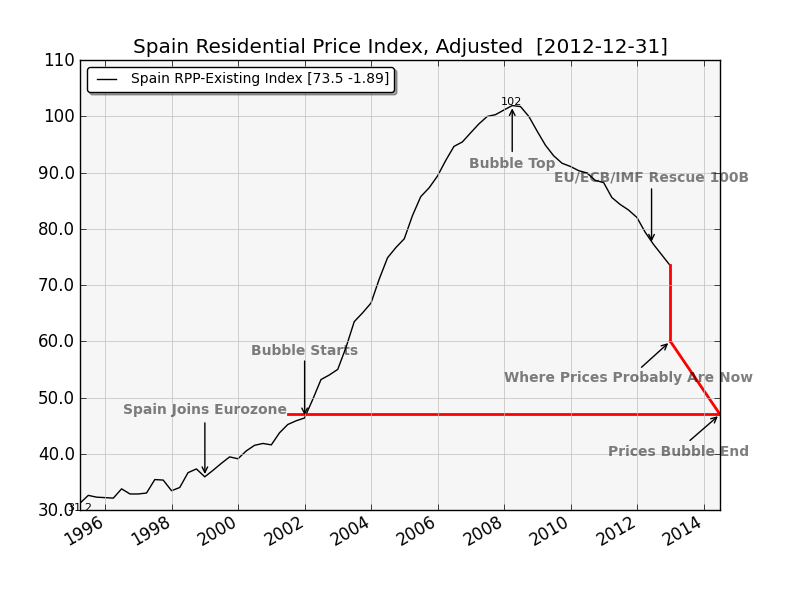
Resolution Cost
In looking at a property bubble, both the gains AND the losses are not confined simply to the homeowner and the mortgage lender. Developers, architects, builders, laborers, and bankers all benefit during the bubble years and suffer after the pop. Yet to examine effects only to those directly affected understates the the multiplying effect on income that the bubble provides. Each beneficiary buys things from other areas of the economy using consumer credit, takes out mortgage loans, companies takes on corporate debt to expand business, materials are extracted and shipped - all based on the phantom income derived from mortgage-bubble created money.
In order to come up with an amount to approximate first the gains, and then the losses due to the bubble, I decided on a simple approach - to use the amount of outstanding bank loans during the bubble years as a proxy for the overall impact of economic activity from the bubble, under the theory that credit money expands as economic activity expands.
In Ireland, where according to my estimates about €440 billion of "bubble loan money" was created, the government eventually spent €143 billion to rescue their banks and buy up (and overpay for) bad loans. So that €143 billion comes to 32% of the total bubble money created. It is entirely possible costs will rise in Ireland, but this number gives us a starting point for the explicit costs to the sovereign.
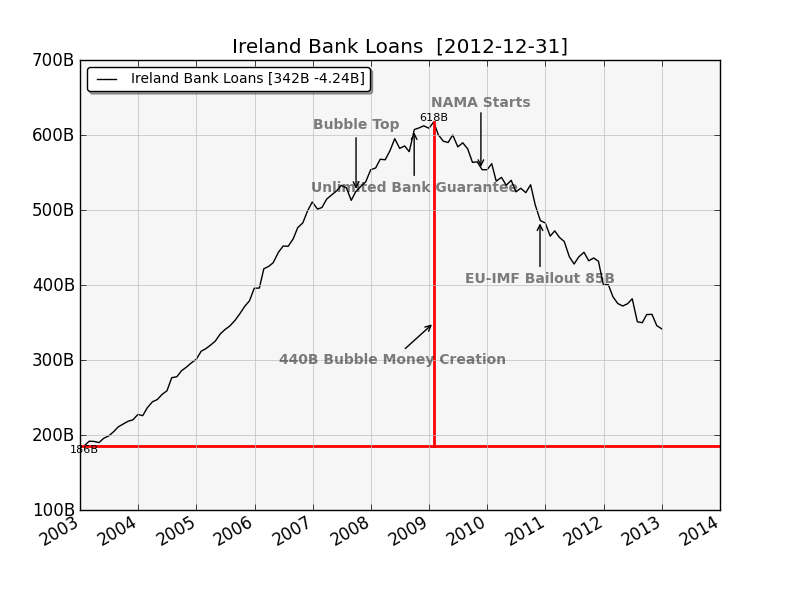
Totaling the bank loans made in the private sector, Spain created about €1.44 trillion in new bank credit during their bubble phase. [note: ECB data only goes back to 2003, so I had to estimate the amount bubble money created in 2002 to be about €100 billion.] If we assume the ratio of costs will be similar to that of Ireland, 32% of €1.44 trillion ends up being €460 billion - half for capital injections, and half for the Bad Bank.
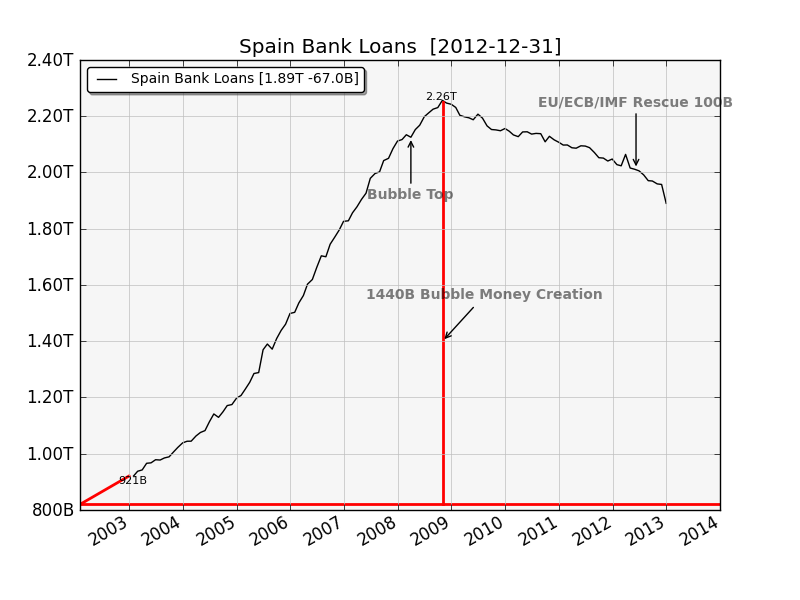
To date, Spain has allocated €32 billion to their Bad Bank [Banco Malo] and an as of yet undetermined amount to their bank rescue/capital injection program. To put it mildly, this doesn't seem like nearly enough.
But is €460 billion the right amount? That's open to debate. It might be more.
A recent corruption scandal in Spain has resulted in PM Rajoy's popularity dropping - a recent survey had 85% of those polled having "little or no faith" in him. His party (the PP) had a 24% support rating, the lowest on record.
Why talk about corruption in a finance discussion? Well, corruption matters a great deal in these affairs - the managers of a Bad Bank have a lot of money to spread around, well-connected bankers have a whole lot of garbage assets they'd love to get rid of for as high a price as possible (and in fact their jobs DEPEND on them selling their garbage for as high a price as possible), and so the risk of overpayment for bad assets increases right along with the level of corruption. The more public money that gets dropped on the banks, the better condition the banks will be in - for paying salaries, bonuses, dividends, and so on, and the smaller the losses will be for bank shareholders and bondholders.
I assert that corruption is likely to raise the cost of the bailout, since the amount of public money that will be funneled to the bank will be maximized in a corrupt regime. I don't think the cost will be any lower than €460 billion, and Rajoy himself once mentioned the figure €500 billion as being required for a complete bank rescue. I do not think that was a number idly constructed from thin air. What's more, I believe that the folks at the Spanish Central Bank and the ECB are not fools. They've done the same math that I have, and Rajoy's remark was simply a political shot across the bows of the ECB in the negotiations over who pays what; a form of "don't mess with me or else the game is up."
It reminds me of the old saw - owe the bank 1000 dollars, the bank owns you. Owe the bank a billion dollars, and you own the bank!
That's all just speculation on my part, but I find it interesting that my math adds up to approximately Rajoy's threat. It wasn't intentional, but that's what came up.
So I believe that €500 billion is a good guess.
How long to return to normal?
The property bubble is over from the standpoint of pricing when property prices return back to their point of origin. (Its quite possible prices will overshoot as well, but lets leave that out of the discussion for now). It would seem that this might complete within the next year or two.
However calculating when the economy will "return to normal" is another matter entirely. Monetary deflation from the bubble sometimes continues long after prices have retraced. This is for several reasons, all of which have to do with the speed at which losses are recognized, as well as the level of debt forgiveness in the economy in question.
Hyman Minsky had a model where he attempted to explain the anatomy of a bubble through finance. In his model, there were three types of borrowers:
• Hedge Borrowers, whose debt repayments (principal, interest, taxes, expenses, etc) could be covered by the economic activity provided by the investment.
• Speculative Borrowers, whose investments could only cover the interest payments, and relied upon capital appreciation (bubble effects) to make up the difference.
• Ponzi Borrowers, whose investments could not even cover interest payments, and relied entirely on capital appreciation for the loan to make economic sense. Many of the subprime/neg-am borrowers fell into this last category.
The first phase of a pop involves rapid deflation, as corporations and finance organizations who were Ponzi and Speculative borrowers and who may legally walk away from their loan obligations do so relatively rapidly - taking perhaps 2-4 years. From the Ireland bubble charts, it seems that corporations bail out faster than the finance borrowers. Of course this depends on the willingness of the banking system to recognize the losses. "Extend and pretend" strategies drag this process out.
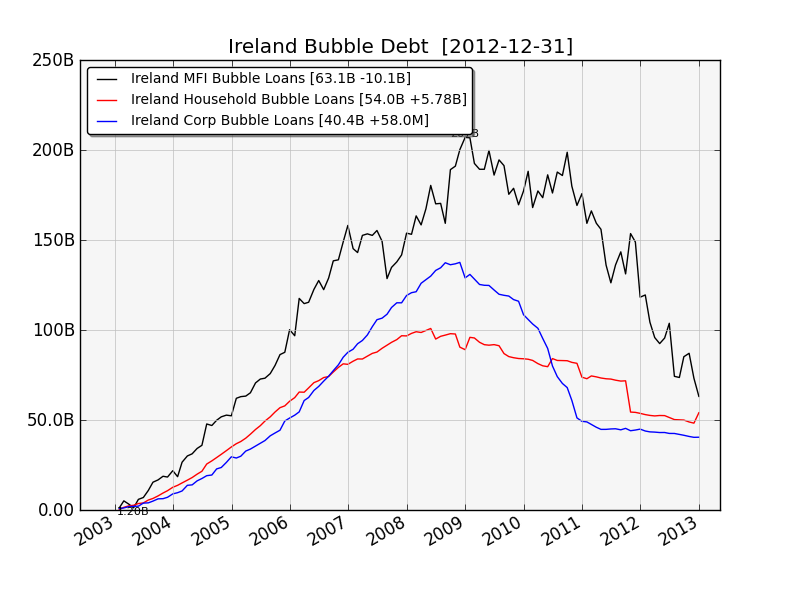
[Note: above chart is an attempt to show the "bubble loans" rather than the total bank loans for the period in question, in order to better compare the different sectors and how much money was created (borrowed) by each one relative to the others]
Losses tend to be the highest for these two types of borrowers; they are the least able to pay, have no money down, and have collateral whose value is entirely based on the former trajectory of bubble pricing. And they can legally walk away. And historically, they do.
Bad Banks tend to buy mostly these sorts of loans, and they have recovery rates that are much lower than those from foreclosed homeowner properties. You can see why - dubious assets such as unbuilt land bought with borrowed money at the top of the bubble is unlikely to have much value once the bubble pops.
The second phase involves hedge borrowers who can actually make the payments but do not want to lose the overvalued asset. By law and custom, regular people are much less willing to simply walk away from an investment gone bad. And in the case of both Spain and Ireland, full recourse laws require a homeowner to continue to make payments regardless of how underwater the homeowner is.
This second phase is also intrinsically deflationary, although the pace of deflation is much slower. In the credit model, money is created when a loan is taken out, and money is destroyed slowly as the loan is gradually paid back or rapidly when the loan is defaulted upon.
After a bubble pop, underwater homeowners are stuck until they pay down enough debt to restore their equity position. This act of slow debt paydown slowly destroys credit money, causing steady monetary deflationary pressure throughout this second phase. Although I have not done the research necessary to back this up, it is my speculation this is what caused the "lost decade" (or two) in Japan - the slow but steady monetary deflationary pressure from gradual debt paydown.
In Ireland, it has been estimated that underwater homeowners will need until 2020 for the bulk of them to get out of negative equity situations - and that is for those who put 20% down. For those who put 0% down and who by law cannot walk away, they will be at it until 2025. This is how long mild deflationary pressures will likely last in Ireland, assuming no changes to the law. In this, Spain is likely to follow Ireland.
The first deflationary phase is steep, lasting perhaps 3-4 years, while the second phase is more shallow and lasts from 8-14 years following, depending on the size of the bubble, as stuck homeowners and corporate hedge borrowers rebuild their equity positions by gradually paying down debt.
Estimating timeline for return to normalcy
We make an assumption that in addition to prices, all the outstanding bank loans that were based on bubble activity will also retrace back to its original starting position - back when the debt was sustainable and justified by steady-state economic activity. As all that unsustainable debt gets defaulted on or paid back, it will vanish.
Graphically, we can track where things are by looking at the outstanding amount of bank loans. In Spain, it is at €1.89 trillion, down from €2.26 trillion at the peak, but it needs to return to about €800 billion before the deflation has run its course. In Spain, it would appear that the first corporate deflationary impulse is in the process of happening now, although it would appear that the Spanish banks have been slow to acknowledge the losses. Based on the Irish experience, it probably has another 2 years to run, assuming the banks are actually required to take their losses.
In some sense this is a moral tale. Corporations get (debt) forgiveness, but in Spain and Ireland regular people don't. This lack of (debt) forgiveness is why the second phase of a deflationary bubble pop will last a long time: it takes people a long time to pay down all that debt. So forgiveness, in addition to it being a Christian virtue, allows things to return to normal more rapidly.
So where are we in Spain? It is just starting to happen seriously, 5 years after the peak in prices. And without changes in the law, it's going to last a very long time.
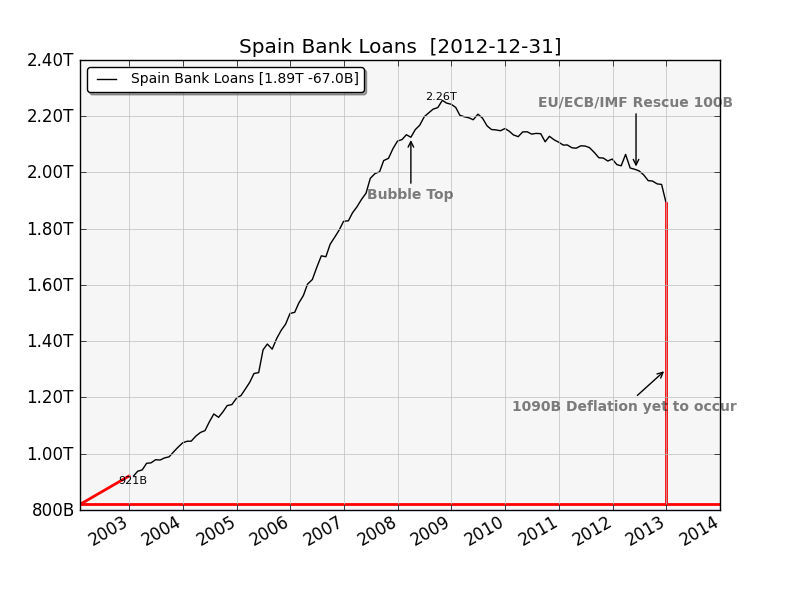
By Raul Ilargi Meijer
Website: http://theautomaticearth.com (provides unique analysis of economics, finance, politics and social dynamics in the context of Complexity Theory)
© 2013 Copyright Raul I Meijer - All Rights Reserved Disclaimer: The above is a matter of opinion provided for general information purposes only and is not intended as investment advice. Information and analysis above are derived from sources and utilising methods believed to be reliable, but we cannot accept responsibility for any losses you may incur as a result of this analysis. Individuals should consult with their personal financial advisors.
Raul Ilargi Meijer Archive |
© 2005-2022 http://www.MarketOracle.co.uk - The Market Oracle is a FREE Daily Financial Markets Analysis & Forecasting online publication.



